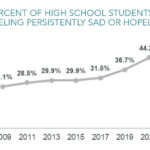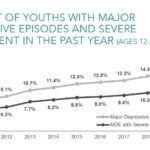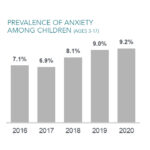September 8, 2022

Learning to Thrive: Integrating Mental Health Services within K-12 Ed
The stresses of modern-day life for children and teenagers are generating overwhelming demand for youth mental health services. Since 2009, adolescents have experienced dramatic increases in depression, anxiety and other conditions. The pandemic has exacerbated this mental health crisis, deepening and complicating the longer-term trend, even as it has enhanced awareness of the need for expanded mental health services.
Approximately one in five children has a diagnosed mental, emotional or behavioral disorder. The number of undiagnosed and borderline cases likely far exceeds this number. Of those, only 20% receive adequate care from specialized mental health providers. Disadvantaged children are even less likely to get the support they need. [1] [2]
Providing appropriate and adequate access to quality mental health services in schools can reduce the need for more intensive downstream interventions, including out-of-district placements and hospitalizations. Timely in-school care can prevent conditions from becoming more acute and help students get back on track more quickly.
Most schools, however, lack the infrastructure, resources and capabilities to offer adequate mental health support to their students. Fortunately, a wave of mental health provider organizations has emerged with scalable models to offer high-quality mental health services in schools. Their technologies and services offer real hope for improving students’ mental health at a time of critical need.
An Epidemic Even Before the Pandemic
In December 2021, U.S. Surgeon General Dr. Vivek Murthy issued a rare advisory to address the growing mental health challenges of America’s youth.
Between 2009 and 2019, the percentage of high school students that seriously considered suicide rose by 36% and the portion that made suicide plans grew by 44%. During this same period, the number of high school students with persistent feelings of sadness and hopelessness increased from 26% to 37%. That percentage further increased to 44% in 2021.
Persistent feelings of sadness and hopelessness can be precursors to or signs of conditions such as depression, anxiety, or self-harm. Though some children and teenagers are more greatly impacted than others, every demographic across every region of the country has experienced an increase in mental health challenges. See charts.



Sources: US Department of Health and Human Services / Centers for Disease Control and Prevention; Substance Abuse and Mental Health Services Administration (SAMHSA)
Other research confirms these alarming trends. An HHS study published in JAMA Pediatrics in March 2022 showed significant increases in anxiety (up 28.9%), depression (up 26.7%) and behavioral conduct problems (up 20%) between 2016 and 2020. Additionally, the 2020 National Survey on Drug Use and Health from the Substance Abuse and Mental Health Services Administration (SAMSHA) showed that the percentage of adolescents experiencing a major depressive episode (MDE) and MDE with severe impairment has steadily risen, reaching 17% and 12%, respectively in 2020.
Researchers speculate that expansive social media use, social and physical isolation and external stressors ranging from global crises to school shootings are contributing factors driving this surge in mental illness and related behaviors. In his advisory, Surgeon General Murthy called for the following:
- Recognition that mental health is an essential part of
overall health. - Increased support for mental health services in educational, community and childcare settings.
- Expanded support for early childhood and education workers.
Schools are a powerful setting in which to offer mental health services. Investing in mental health service provision at schools generates an expansive and positive societal return.
With appropriate and timely mental health interventions, student attendance, grades and test scores improve as does engagement in academic and extracurricular activities. By addressing students’ underlying behavioral, emotional and psychological issues, schools create more harmonious learning environments with fewer disruptions.
Because all children have the right to a free education, addressing mental health services in schools also provides an opportunity to eliminate some of the inherent barriers to accessing services. Schools offer the opportunity to meet the needs of a broad cross section of young people, across demographics, socioeconomic classes, races and cultures.
School staff spend a significant amount of time observing and assessing students, which makes teachers, administrators and counselors who have received the appropriate training well-positioned to monitor and flag students for potential mental or behavioral health needs. Half of all mental illnesses begin by age 14; early detection and intervention are critical to improving outcomes.
Nevertheless, the expansion of mental health services within schools has proven difficult. Schools face internal competition for limited resources and a paucity of staff trained in mental health services. The availability of and pathway to funding for schools to offer holistic, preventative mental health services also varies state-to-state and district-to-district. School-based providers must also adapt to regional and cultural variations in access to and attitudes toward mental health, including the stigma that such needs can still provoke.
There are several innovative, impactful companies successfully addressing this massive mental health need and market opportunity. The following companies are pioneers in the field, helping support the integration of mental health services and K-12 education with innovative programs and platforms.
 In-School Services
In-School Services
Effective School Solutions
Effective School Solutions (ESS) partners with school districts to help them implement culturally-inclusive mental health and behavioral support programs that improve care, strengthen outcomes, address trauma and maintain students in their home districts.
ESS CEO Duncan Young observed that many students with acute mental health needs had historically been served via out-of-district placements into therapeutic day schools. ESS was founded on the belief that local schools can meet many of these students’ mental health service needs with the appropriate support. Young says,
Our fundamental idea is to provide students with an equal or even better level of therapeutic care than they would receive in a private school environment. By keeping students in their home district, we can help them thrive socially and academically while addressing their need for care.
Starting with two districts, the company now works with over 120 districts across nine states. ESS uses a Multi-Tiered System of Support (MTSS) framework, focused on wellness, prevention and appropriate interventions.
At the foundational level, ESS helps schools assess their students’ mental health needs and develop mental health programs. Tier 1 services include training for educators and parents so that they can identify at-risk students. Tier 2 offers clinical programming for students with mild to moderate needs, and crisis assessment, response and reentry programs. Tier 3 includes intensive,
in-school clinical support services for students with acute mental health challenges.
Providing preemptive in-school services for Tier 3 students can enable districts to avoid expensive out-of-district placements, much like better primary care helps reduce emergency department visits and hospitalizations. Young notes,
Our pioneering innovation was to take a level of mental health care generally only found in private therapeutic schools and adapt it for the public school setting. We’re still the only organization doing that at national scale.
ESS creates pleasant physical spaces within their schools that are therapeutically friendly. Clinicians work one-on-one or in small cohorts with students and families, sometimes over several years. Contracting directly with districts helps ESS provide flexible care tailored to student needs. “We have a proven therapeutic approach,” Young says, “and clear efficacy data backing up our approach. But our true north is what’s best for the student, even if it means coloring outside the lines.”
ESS tracks data on every student who receives their services. The company is experimenting with data-driven tools for screening and identifying mental health needs preemptively.
SPG Therapy & Education, a division of Unison Therapy Services
California-based SPG Therapy & Education is part of a family of companies operating in California and Colorado under Unison Therapy Services, a portfolio company of Ridgemont Equity Partners.
Founded 30 years ago, SPG originally worked with school districts to deliver speech therapy services. Over time, SPG’s founder, Susan Stark, expanded the company’s service offerings through a multidisciplinary platform that incorporates autism support services, occupational therapy, physical therapy, specialized education supports, behavioral intervention, school psychology and mental health services.
SPG’s school-based psychologists and mental health therapists provide comprehensive services including mental health assessments, individualized education plan (IEP) evaluations, student counseling, parent support and developmental training for school therapists, counselors, teachers and staff. The multidisciplinary team members work closely with staff, administrators, teachers and case managers to provide or coordinate therapy in school, in the community and through placement programs.
Over the past year, the company’s in-school psychology and mental health service business has tripled in size. SPG also offers remote therapy services, which is particularly helpful in improving access for rural school districts and areas with extreme staffing shortages.
As a clinically-driven company, SPG meets the holistic needs of students through coordinated, collaborative care. Stark says, “We’re focused on collaborating with district staff to ensure our partnering districts trust us to be a multidisciplinary provider that fully supports their students’ needs in wonderfully diverse communities.”
To achieve that, the company knows it’s critical to provide meaningful and extensive support to its clinicians and therapists, along with partnering district personnel. As COO Chris Holmes notes, “A big part of what we’re doing is providing supervision, guidance and assistance to all our practitioners in the field, so they have the resources, ideas and help they need.”
In addition to school-based services, Unison also provides behavioral support services in the community through home and center-based services. “This provides even further insight into the collaboration that is needed between school and home,” says Todd Ezrine, CEO. “We know that having a continuum of care across care settings puts us in the best place to identify needs and respond quickly with innovative solutions.”
Virtual Services
Hazel Health
California-based Hazel Health provides virtual mental and physical health services to two million K-12 students. Venture-backed by Owl Ventures and Bain Capital Ventures, Hazel started as a virtual urgent care provider offering schools on-demand access to pediatricians or nurse practitioners.
Chief Innovation Officer Andrew Post expanded Hazel’s virtual model for physical care to offer mental health triage and preventative services. With its HIPAA-compliant video platform, Hazel provides students with timely access (in days versus weeks or months) to licensed clinical social workers or mental health professionals.
Initially, Hazel offers short-term video therapy services directly to students, usually for up to 6 or 8 sessions. After assessment, they coordinate with locally-based providers for ongoing, in-person care if necessary.
Hazel’s contracts typically cover a school district’s entire student population or even an entire state’s (Hawaii). As such, Hazel increases access and promotes health equity through care delivery tailored to students’ needs rather than restrictive reimbursement formularies. Andrew Post believes this approach benefits students and the district.
As a business model, that wouldn’t work for most providers because the customer acquisition cost is too high to serve a student for limited sessions. But our platform model enables us to be an ideal partner to the school and a bridge to community-based providers.
As a former principal and district assistant superintendent, Post understands the challenges that schools face. “Schools have not always thought about mental health as their problem to solve. They have enough problems, and limited recruitment resources needed to ensure that instructional positions are filled, first and foremost. But meeting mental health needs in school helps with prevention, quality of education and academic performance.”
DotCom Therapy
Founded in 2015 by Rachel Mack Robinson, Madison, WI-based DotCom Therapy provides virtual teletherapy services to over 400 schools and healthcare partners across 41 states. Its service lines include occupational therapy, mental health counseling, speech therapy and staff development.
Each district has a customer success manager (CSM) who coordinates across multiple specialties and helps manage service provision, including in-person support. This approach helps the company develop close working relationships with their schools and communities.
Robinson emphasizes the intricacies of their approach,
In every school, we deploy customer success managers who serve as the point of contact for the school and determine what services and resources will meet the school’s unique needs. On the flip side, our clinical management team works with our providers to make sure they get the training, mentoring, support and school-based partners they need to feel connected and effective. That’s how we can cover this massive geography and still focus on serving our communities and therapists.
DotCom has recently developed a technology platform for schools to meet student’s holistic needs. Robinson explains:
Our new platform is one of the first in the industry to enable schools to work on a student’s individualized education plan and for pediatricians to send a direct referral. The patient can use the platform to create an account, match with a therapist, schedule an appointment and process their insurance payment. That removes the administrative burden from schools and families and enables more students to get support.
DotCom Therapy completed a Series A funding round in 2021 led by New Capital Partners and has expanded its services beyond the school setting, forming partnerships with payer and provider organizations as well as serving customers directly. The company also offers a new program called Wolf + Friends, a community network for providers and parents of children with neuro and physical disabilities and developmental delays.
Institutional Services
LearnWell
By law, under the Individuals with Disabilities Education Act (IDEA), each state must provide free appropriate public education (FAPE) services to students in hospitals, residential treatment and other care settings. This includes students receiving treatment for mental illnesses or emotional disturbances. Many school districts, however, lack the teachers and support to meet the FAPE mandates under IDEA effectively. Plymouth, MA-based LearnWell provides education services to students in inpatient, residential, and PHP/IOP programs. Today, LearnWell, a portfolio company of 424 Capital, provides services in more than 175 facilities across 25 states.
LearnWell’s 150-200 teachers work in classrooms where students vary by age, aptitude, study need and mental health challenges. LearnWell works with districts to ensure each teacher has appropriate lesson plans for each student, and coordinates with facilities and families to best serve the students.
Students rotate through programs quickly, but the aim is to help them keep up with their schoolwork so they can return to class more easily. LearnWell COO Kathleen Egger knows this places a heavy burden on LearnWell’s teachers.
On average, our teachers stay about three years. They need tremendous adaptability to manage a range of students in an institutional setting. For some, it’s a great fit. We often hear from students who are incredibly grateful to a teacher who provided them with close attention at a difficult time and helped them return to their own school.
LearnWell uses Salesforce to track business operations metrics with school customers, as well as the attendance and progress of students. They also keep close tabs on their hospitals and teachers to monitor their level of satisfaction.
In 2020, LearnWell broadened its family of services with the acquisition of Comprehensive Counseling, a New York and Massachusetts-based provider of outpatient mental health services with a focus on making mental health more accessible and affordable.
Funding Success
Historically, much of the funding for mental and behavioral health services in the education setting has come from the Individuals with Disabilities Education Act (IDEA) and the Every Student Succeeds Act. There are also several pathways for states to provide funding for school-based mental health services through Medicaid programs. [3] In response to the growing need for mental health services, federal and local authorities are also implementing new programs. Examples of state-based initiatives include:
- South Carolina’s “Psychosocial Behavioral Health Rehabilitative Medicaid Standard,” which enhances funding for and coverage of school-based services;
- Michigan’s revised IDEA, which expands counseling services for students with an elevated risk for or an existing mental health concerns;
- Nevada’s state-funded block grant to provide social workers in schools that address mental/behavioral health issues;
- California’s tax on personal income that supports mental health initiatives, including comprehensive school-based programs as well as its recent $4.4 billion Youth and Child Behavioral Health Initiative that enables students to receive mental health services without a medical diagnosis;
- Maryland’s 2018 Safe to Learn Act, which funds mental health infrastructure, training, and implementation;
- Minnesota’s grant funding from Project AWARE (Advancing Wellness and Resiliency in Education) will be used to develop a framework for mental health services in schools.
New Federal initiatives include the following:
- $190 billion in pandemic relief support to schools that they can use to support student mental health services;
- $353 million in funding through the 2022 Consolidated Appropriations Act for Department of Education programs that increases the availability of mental health services in schools, with $111 million specifically devoted to professional development for teachers who deliver mental health programs;
- Block grants to states to expand mental health services through the Center for Mental Health Services (CMHS).
Conclusion: A Brighter Future for Students & Schools
Despite evidence that mental health support leads to better academic performance, reductions in the need for special education services, fewer disciplinary encounters and higher graduation rates, in-school mental health services remain insufficient. Many educators and school administrators recognize the need for a proactive, preventive approach but often lack the resources or capabilities to implement effective programs. 
Fortunately, innovators such as ESS, SPG, Hazel, DotCom and LearnWell have robust private equity financing that has enabled them to grow in recent years with solutions that help schools provide access to quality care. They are providing more effective mental health services more efficiently, increasing access to these critical services for students across the country.
Heightened awareness and increased funding are advancing access to mental health services for America’s youth. In response, innovative, mission-driven companies are emerging to scale their services to meet increasing need. After a dark period of rising demand coupled with insufficient access to care, our children’s futures are beginning to look brighter.
Sources
1. https://www.cdc.gov/childrensmentalhealth/access.html
2. https://ps.psychiatryonline.org/doi/full/10.1176/appi.ps.201900575
3. Joint Information Bulletin from SAMHSA and CMS (https://store.samhsa.gov/sites/default/files/d7/priv/pep19-school-guide.pdf)
Disclaimer
The information contained in this report was obtained from various sources, including third parties, that we believe to be reliable, but neither we nor such third parties guarantee its accuracy or completeness. Additional information is available upon request. The information and opinions contained in this report speak only as of the date of this report and are subject to change without notice.
This report has been prepared and circulated for general information only and presents the authors’ views of general market and economic conditions and specific industries and/or sectors. This report is not intended to and does not provide a recommendation with respect to any security. Cain Brothers, a division of KeyBanc Capital Markets (“Cain Brothers”), as well as any third-party information providers, expressly disclaim any and all liability in connection with any use of this report or the information contained therein. Any discussion of particular topics is not meant to be comprehensive and may be subject to change. This report does not take into account the financial position or particular needs or investment objectives of any individual or entity. The investment strategies, if any, discussed in this report may not be suitable for all investors. This report does not constitute an offer, or a solicitation of an offer to buy or sell any securities or other financial instruments, including any securities mentioned in this report. Nothing in this report constitutes or should be construed to be accounting, tax, investment or legal advice. Neither this report, nor any portions thereof, may be reproduced or redistributed by any person for any purpose without the written consent of Cain Brothers and, if applicable, the written consent of any third-party information provider.
“Cain Brothers, a division of KeyBanc Capital Markets” is a trade name of KeyBanc Capital Markets Inc. Member FINRA/SIPC.
KeyBanc Capital Markets Inc. and KeyBank National Association are separate but affiliated companies. Securities products and services are offered by KeyBanc Capital Markets Inc. and its licensed securities representatives. Banking products and services are offered by KeyBank National Association. Credit products are subject to credit approval. Copyright © 2022 KeyCorp.






